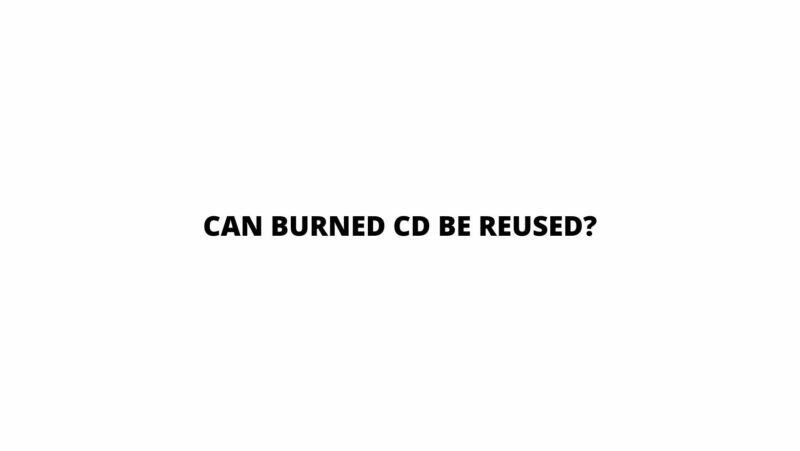In an age defined by rapid technological evolution, the question of reusing burned Compact Discs (CDs) resonates with both environmental consciousness and practicality. As a popular medium for storing and sharing content, CDs have played an essential role in preserving memories, distributing software, and archiving data. Amidst this landscape, the possibility of reusing burned CDs emerges as a topic of interest and curiosity. This article delves into the intricacies of reusing burned CDs, the underlying mechanisms of CD burning, the challenges of reusing them, and innovative strategies to extend the life of these optical discs.
- The Art of CD Burning: A Primer
Before exploring the concept of reusing burned CDs, it’s crucial to understand the process of CD burning. CD burning involves writing digital data onto a blank CD-R (recordable) or CD-RW (rewritable) disc using a laser. The laser etches microscopic pits and lands onto the dye layer of the disc, creating a pattern that represents binary code—this pattern is read by CD players and drives.
- The Possibility of Reusing Burned CDs
The potential for reusing burned CDs depends on various factors, including the type of disc, the data written on it, and the condition of the disc’s dye layer. CD-R discs are typically write-once media, meaning that once data is burned onto them, it cannot be altered or overwritten. CD-RW discs, on the other hand, are rewritable and can be erased and rewritten multiple times.
- Challenges of Reusing Burned CDs
While CD-RW discs are designed for multiple uses, the process of reusing burned CDs presents several challenges:
- Data Erasure: Erasing data from a CD-RW disc requires specialized software and hardware. This process may not be as straightforward as simply deleting files from a rewritable USB drive or hard disk.
- Quality Degradation: With each rewrite, the dye layer of a CD-RW disc undergoes stress, which can lead to a decrease in data quality over time. This degradation may affect the readability of data and limit the number of times the disc can be reused.
- Compatibility Issues: Reused CD-RW discs might not be compatible with all CD players and drives, especially older ones that were not designed to handle rewritable media.
- Strategies for Reusing CD-RW Discs
For those interested in reusing CD-RW discs, certain strategies can be adopted to optimize the potential for multiple uses:
- Data Management: Keep track of the number of times a CD-RW disc has been rewritten. This awareness helps gauge the disc’s remaining lifespan and ensures timely data transfer to more durable storage solutions.
- Regular Backups: Before reusing a CD-RW disc, make backups of its content to prevent data loss due to potential degradation or compatibility issues during the reuse process.
- Quality Checks: After each rewrite, inspect the CD-RW disc for signs of degradation or readability issues. A disc scanning utility can be used to analyze and assess the quality of the disc’s data.
- Creative Applications of Reusing CDs
While traditional data storage might pose challenges, creative applications of reusing burned CDs have gained popularity. Artists, crafters, and DIY enthusiasts have repurposed old CDs for projects such as mosaic artwork, sun catchers, coasters, and even reflective garden ornaments. These endeavors extend the life of CDs in artistic and sustainable ways.
- Environmental Considerations: Reuse vs. Recycling
The environmental impact of reusing burned CDs versus recycling them is an important consideration. Reusing CDs reduces electronic waste and conserves resources used in the manufacturing process. However, recycling CDs requires specialized facilities due to the presence of various materials, including plastics, aluminum, and dye layers. It’s essential to research local recycling programs that accept CDs and explore responsible disposal options.
- The Evolution of Storage Solutions
While reusing burned CDs has its merits, it’s important to recognize the evolving landscape of storage solutions. Advances in technology have introduced more efficient and durable options, including solid-state drives (SSDs), cloud storage, and high-capacity USB drives. These alternatives offer faster access times, greater storage capacities, and enhanced data protection.
- Future Trends and Innovation
As technology continues to progress, the concept of reusing burned CDs might evolve. Research and development efforts may yield innovative methods for extending the life of burned CDs or repurposing them for new applications.
Conclusion
The possibility of reusing burned Compact Discs (CDs) embodies a balance between practicality, environmental consciousness, and creative potential. While CD-RW discs offer the prospect of multiple uses, challenges such as data erasure, quality degradation, and compatibility must be considered. Strategies for optimizing the potential of reusing CD-RW discs, combined with creative applications in art and craft, underscore the versatility of these optical discs.
As technology continues to advance, it’s crucial to acknowledge the emergence of alternative storage solutions that offer greater capacities, durability, and accessibility. While reusing burned CDs may hold sentimental value and environmental benefits, adapting to the changing technological landscape ensures that data preservation remains efficient and effective. The journey of reusing burned CDs unfolds as a testament to human ingenuity, resourcefulness, and the enduring potential of digital and physical media.


